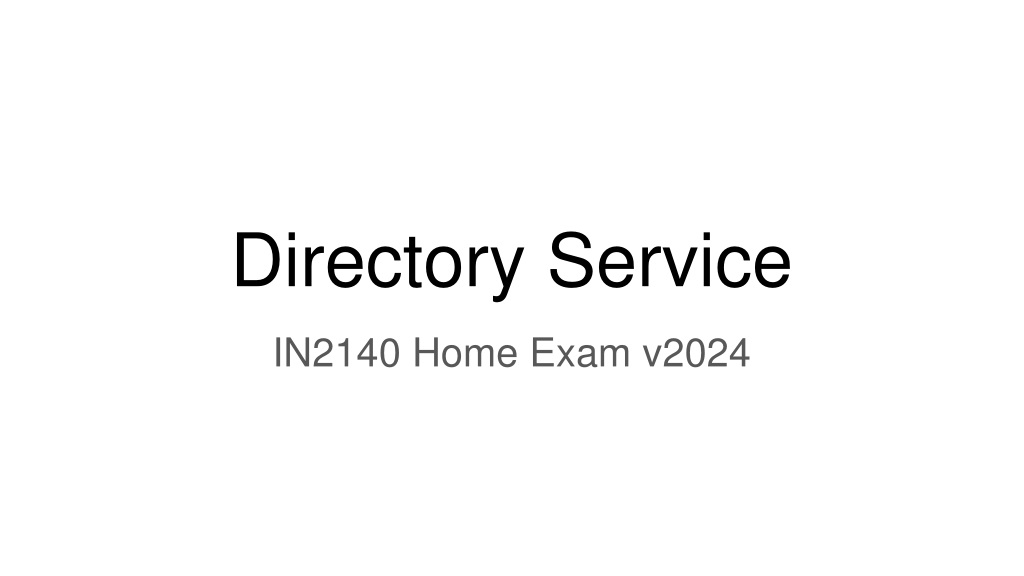

Replay
0 likes | 2 Views
Directory services play a crucial role in computer networks by providing organized and structured information in response to user queries. This text explains the function of directory services, their differentiation from web search, and the implementation steps for building a client-side tree from server responses using communication over UDP. The content includes details on D1 and D2 protocols, packet structures, request/response mechanisms, and tree node configuration. Utilize the provided resources to practice and develop understanding in directory service communication.

E N D
Directory Service IN2140 Home Exam v2024
What does a directory service do? ● Directory services can be primitive or complex ● In principle, a directory server responds to queries from a user ○ The answer depends on the query ○ But also on the user and their attributes ○ Responses don’t change when query and attributes are unchanged and the directory has not changed ● Different from web search, which sacrifices accuracy for scale and speed
In the exam Request: ID A client asks for the directory information for an ID (ID>1000). Client Server The server retrieves several values that are structured in a tree. Response: 8239 28623 23489 The values are simplified to some integers. In a real application these could be user permissions, files, … 31185 2315 4128 9784 52137
In the exam Request: 3454 A client asks for the directory information for an ID (ID>1000). Client Server The server retrieves several values that are structured in a tree. ResponseSize: 8 Response The values are simplified to some integers. In a real application these could be user permissions, files, … 8239 28623 31185 2315 9784 LastResponse 23489 4128 52137
8239 In the exam 28623 23489 The client prints the received response in a tree pattern to the screen. 31185 2315 4128 9784 52137 Client The output shows the tree structure in a simplified form. 8239 --28623 ----31185 ----2315 ------9784 --23489 ----4128 ------52137 Note: the client and server can store the tree internally however they want.
In the exam You implement functions in the client ● The client is a white box, you have the source. ● The client functions are in grey. They are yours, you have some precode. ● The server is a black box, you find binaries on Github. Client D1 module Server D2 module Tree module
3 steps to do this 1. Communication over UDP a. called “D1” b. with checksums and 1-bit acknowledgements 2. Request/Response protocol a. called “D2” b. on top of UDP c. relies on correct packet delivery using D1 3. Build a client-side tree from the Responses a. Parse the payload of the D2 packets b. Recreate the tree on the client side (you don’t have to use pointers) c. Print the tree on screen
Communication over UDP The packet header for D1: sent over the network in network byte order ACK packet if this is 1 ACK number MSB Checksum: 16 bits, network byte order Size: 32 bits, network byte order LSB Sequence number, 0 or 1 if DATA packet DATA packet if this is 1 12 unused bits, must be 0
Communication over UDP The D1 packet: payload follows D1Header, protected by checksum . . . Payload, up to 1016 more bytes struct D1Header { uint16_t flags; uint16_t checksum; uint32_t size; }; typedef struct D1Header D1Header;
D2: Request/Response protocol The D2 packet: in the payload of the D1 packets (as usual in layering) type struct PacketHeader { uint16_t type; }; #define TYPE_REQUEST (1 << 0) /* type is PacketRequest */ #define TYPE_RESPONSE_SIZE (1 << 1) /* type is PacketResponseSize */ #define TYPE_RESPONSE (1 << 2) /* type is PacketResponse */ #define TYPE_LAST_RESPONSE (1 << 3) /* type is PacketResponse */
D2: Request/Response protocol The D2 packet: in the payload of the D1 packets (as usual in layering) TYPE_REQUEST unused - set to 0 for checksumming ID struct PacketRequest { uint16_t type; uint32_t id; };
D2: Request/Response protocol The D2 packet: in the payload of the D1 packets (as usual in layering) TYPE_RESPONSE_SIZE size struct PacketResponseSize { uint16_t type; uint16_t size; };
D2: Request/Response protocol The D2 packet: in the payload of the D1 packets (as usual in layering) payload_siez . . . payload struct PacketResponse { uint16_t type; uint16_t payload_size; }; TYPE_RESPONSE OR TYPE_LAST_RESPONSE
Tree nodes: the payload of D2 ID value Num_children (here 2) ID of child[0] ID of child[1] id: 0-based index created by depth-first search on the server struct NetNode { uint32_t id; uint32_t value; uint32_t num_children; uint32_t child_id[5]; }; value: our MacGuffin Up to 5 children But unused children fields are not sent over the network.
The servers Your client code must talk to our servers Find binaries at https://github.uio.no/IN2140v2/in2140-v24-he ● d1_dump <port> ○ Send one of your D1 packets to this server. The server checks whether your D1 header is as expected. ● d1_server <port> ○ The d1_test_client with your implementation of d1_udp.c can connect to this server and send a few ping-pong messages. ● d2_server <port> ○ The d2_test_client with your implementations of d1_udp.c and d2_lookup.c can connect to this server. The client sends a Request with an ID and the server answers with several Response packets with tree nodes.
The servers Your client code must talk to our servers Find binaries at https://github.uio.no/IN2140v2/in2140-v24-he ● Currently available for ○ Linux Redhat 8.9 on Intel (static binary) ■ this works on IFI’s computers, login.ifi and in machines in Sed ○ Linux Ubuntu 22.04 on Intel (static binary) ■ this is popular for home use (and may work with WSL2) ○ MacOS 14.4 Sonoma on Intel (dynamic binary) ■ only Intel; no access to an ARM Mac
